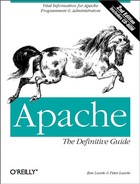3.12. Restarts
A webmaster will sometimes want to kill Apache and restart it with a new Config file, often to add or remove a virtual host. This can be done the brutal way, by stopping httpd and restarting it. This method causes any transactions in progress to fail in what may be an annoying and disconcerting way for the clients. A recent innovation in Apache was a scheme to allow restarts of the main server without suddenly chopping off any child processes that were running.
![]() There are three ways to restart Apache under Unix:
There are three ways to restart Apache under Unix:
 Kill and reload Apache, which then rereads all its Config files and
restarts:
Kill and reload Apache, which then rereads all its Config files and
restarts:% kill PID % httpd [ flags ]
 The same effect is achieved with less typing by using the
flag -HUP
to kill Apache:
The same effect is achieved with less typing by using the
flag -HUP
to kill Apache:% kill -HUP PID
 A graceful restart is achieved with the flag
-USR1. This rereads the Config files
but lets the child processes run to completion, finishing any client
transactions in progress, before they are replaced with updated
children. In most cases, this is the best way to proceed, because it
won't interrupt people who are browsing at the time (unless you
messed up the Config files):
A graceful restart is achieved with the flag
-USR1. This rereads the Config files
but lets the child processes run to completion, finishing any client
transactions in progress, before they are replaced with updated
children. In most cases, this is the best way to proceed, because it
won't interrupt people who are browsing at the time (unless you
messed up the Config files):% kill -USR1 PID
 A script to do the job automatically (assuming you are in the
server root directory when you run it) is as follows:
A script to do the job automatically (assuming you are in the
server root directory when you run it) is as follows:#!/bin/sh kill -USR1 `cat logs/httpd.pid`
![]() Under Win32 it is enough to open a second
MS-DOS window and type:
Under Win32 it is enough to open a second
MS-DOS window and type:
apache -k shutdown|restart
![]() See Section 2.2 in Chapter 2.
See Section 2.2 in Chapter 2.
